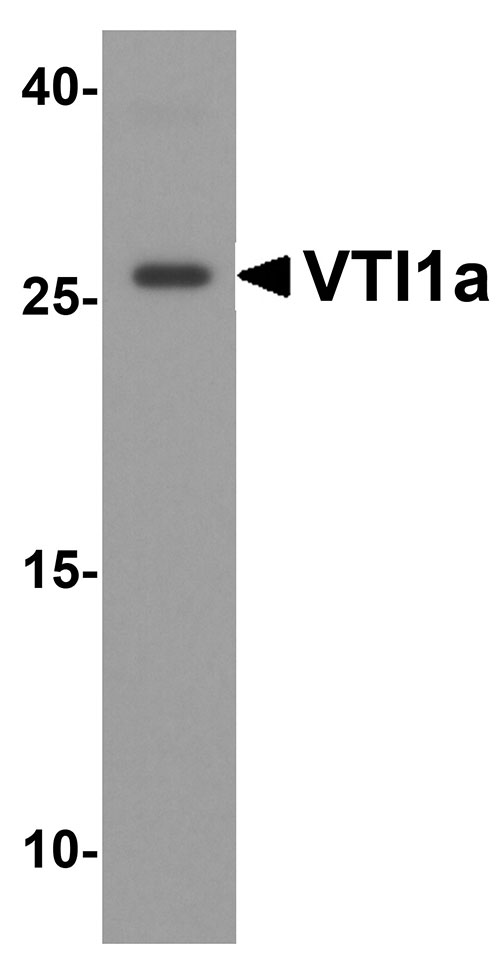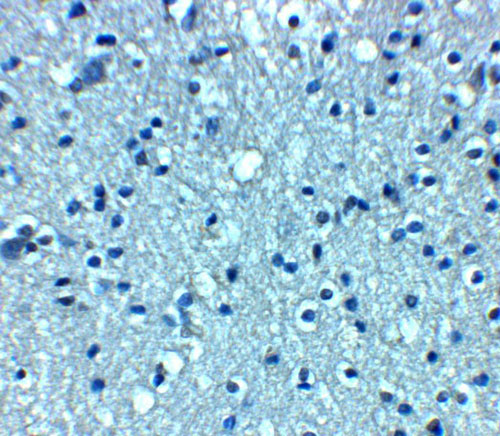VTI1a Antibody
- SPECIFICATION
- CITATIONS
- PROTOCOLS
- BACKGROUND

Application
| WB, IHC, E |
|---|---|
| Primary Accession | Q96AJ9 |
| Other Accession | NP_660207, 113374156 |
| Reactivity | Human, Mouse, Rat |
| Host | Rabbit |
| Clonality | Polyclonal |
| Isotype | IgG |
| Calculated MW | Predicted: 24, 27 kDa; Observed: 26 kDa |
| Application Notes | VTI1a antibody can be used for detection of VTI1a by Western blot at 1 - 2 µg/ml. Antibody can also be used for immunohistochemistry starting at 5 µg/mL. |
| Gene ID | 143187 |
|---|---|
| Target/Specificity | VTI1a; VTI1a antibody is human, mouse and rat reactive. At least two isoforms of VTI1a are known to exist; this antibody will detect both isoforms. VTI1a antibody is predicted to not cross-react with VTI1b. |
| Reconstitution & Storage | VTI1a antibody can be stored at 4℃ for three months and -20℃, stable for up to one year. |
| Precautions | VTI1a Antibody is for research use only and not for use in diagnostic or therapeutic procedures. |
| Name | VTI1A |
|---|---|
| Function | V-SNARE that mediates vesicle transport pathways through interactions with t-SNAREs on the target membrane. These interactions are proposed to mediate aspects of the specificity of vesicle trafficking and to promote fusion of the lipid bilayers. Involved in vesicular transport from the late endosomes to the trans-Golgi network. Along with VAMP7, involved in an non-conventional RAB1-dependent traffic route to the cell surface used by KCNIP1 and KCND2. May be involved in increased cytokine secretion associated with cellular senescence. |
| Cellular Location | Cytoplasmic vesicle. Golgi apparatus membrane; Single-pass type IV membrane protein |

Thousands of laboratories across the world have published research that depended on the performance of antibodies from Abcepta to advance their research. Check out links to articles that cite our products in major peer-reviewed journals, organized by research category.
info@abcepta.com, and receive a free "I Love Antibodies" mug.
Provided below are standard protocols that you may find useful for product applications.
Background
Vesicle transport through interaction with t-SNAREs homolog 1 (VTI1a and VTI1b) are involved in vesicular transport from the late endosomes to the trans-Golgi network (1). They are both localized in the trans-Golgi network, with VTI1a also found in the Golgi apparatus and VTI1b in endosomes (2,3). VTI1a mediates vesicle transport pathways through interactions with t-SNAREs on the target membrane and promotes fusion of the lipid bilayers (4). VTI1a may be concerned with increased secretion of cytokines associated with cellular senescence (5).
References
Fischer VM and Stevens TH. A human homolog can functionally replace the yeast vesicle-associated SNARE Vti1p in two vesicle transport pathways. J. Biol. Chem. 1998; 273:2624-30.
Kreykenbohm V, Wenzel D, Antonin W et al. The SNAREs vti1a and vti1b have distinct localization and SNARE complex partners. Eur. J. Cell Biol. 2002; 81:273-80.
Antonin W, Riedel D, von Mollard GF, et al. The SNARE Vti1a-beta is localized to small synaptic vesicles and participates in a novel SNARE complex. J. Neurosci. 2000; 20:5724-32.
Atlashkin V, Kreykenbohm V, Eskelinen EL, et al. Deletion of the SNARE vti1b in mice results in the loss of a single SNARE partner, syntaxin 8. Mol. Cell Biol. 2003; 23:5198-207.
If you have used an Abcepta product and would like to share how it has performed, please click on the "Submit Review" button and provide the requested information. Our staff will examine and post your review and contact you if needed.
If you have any additional inquiries please email technical services at tech@abcepta.com.













 Foundational characteristics of cancer include proliferation, angiogenesis, migration, evasion of apoptosis, and cellular immortality. Find key markers for these cellular processes and antibodies to detect them.
Foundational characteristics of cancer include proliferation, angiogenesis, migration, evasion of apoptosis, and cellular immortality. Find key markers for these cellular processes and antibodies to detect them. The SUMOplot™ Analysis Program predicts and scores sumoylation sites in your protein. SUMOylation is a post-translational modification involved in various cellular processes, such as nuclear-cytosolic transport, transcriptional regulation, apoptosis, protein stability, response to stress, and progression through the cell cycle.
The SUMOplot™ Analysis Program predicts and scores sumoylation sites in your protein. SUMOylation is a post-translational modification involved in various cellular processes, such as nuclear-cytosolic transport, transcriptional regulation, apoptosis, protein stability, response to stress, and progression through the cell cycle. The Autophagy Receptor Motif Plotter predicts and scores autophagy receptor binding sites in your protein. Identifying proteins connected to this pathway is critical to understanding the role of autophagy in physiological as well as pathological processes such as development, differentiation, neurodegenerative diseases, stress, infection, and cancer.
The Autophagy Receptor Motif Plotter predicts and scores autophagy receptor binding sites in your protein. Identifying proteins connected to this pathway is critical to understanding the role of autophagy in physiological as well as pathological processes such as development, differentiation, neurodegenerative diseases, stress, infection, and cancer.



